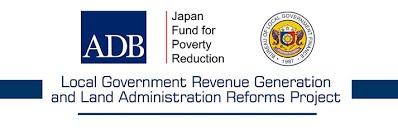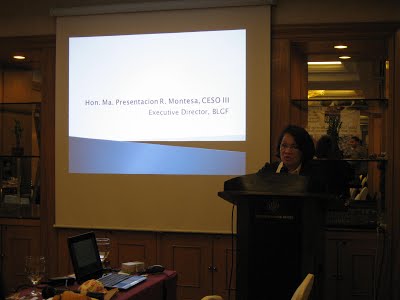Regala Project

Support to Local Government Revenue Generation and Land Administration Reforms Project or REGALA Project is a project financed through grant by the Japan Fund for Poverty Reduction and administered by the Asian Development Bank.
Building on the gains and experiences of the LAMP2 - Innovation Support Fund funded by the Australian Government through the Australian Agency for International Development (AusAID), the ADB-JFPR Project seeks to expand the delivery of economic and social services in nine (9) participating Local Government Units (LGUs) through improved land administration and management (LAM) and valuation systems. The Philippine Government's executing agency as approved by the ADB-JFPR is the Department of Finance's Bureau of Local Government Finance (BLGF).

Component 1 of the Project seeks to institutionalize LAM good practices models where two (2) former LAMP2-ISF Programmatic LGUs will be selected to be provided with technical assistance and capability building to ensure their development as good practice models in the LAM training network. Technical assistance in the form of training/capacity building and experts inputs will be provided to the 2 mature LGUs that will be selected.
Component 2 seeks to extend LAM activities in two (2) former LAMP2-ISF small grant LGUs. The grant will fund the procurement of additional equipment, training and capacity building, expert inputs and limited operational funds to support full operation of unified land information and revenue systems and adoption of reforms on valuation, land management, and investment planning.

Component 3 seeks to provide small LAM grants to three new LGUs. This will entail the competitive selection of new LGUs through the Leagues of Provinces, Cities, and Municipalities, and the interagency grant awards committee. Criteria include leadership, track record in managing interagency cooperation, project preparedness, and commitment of the LGU and its partners to LAM reform. LGUs will commit to set up the appropriate organization structures and mechanisms, and to provide at least a 25% counterpart fund to the grant.
Component 4 seeks to provide support to one provincial and one municipal LGU. The objective is to strengthen the role of the province in rolling out LAM initiatives. A provincial LGU will be selected where an ISF LGU is located (preferred) that has demonstrated capacity for replication of LAM technologies, and good leadership and a track record in inter-agency cooperation and collaboration.This provincial LGU will have committed to partnerships between the LGUs and their LAM agency partners. A counterpart fund of at least 25% is required. A municipality within the province will also be assisted to serve as a pilot for a provincial ISF LGU model.
Project will run from August 2011 to July 2013.
LGU Selection Criteria
Basic criteria for selection include the following:
• Compliance with grant application requirements;
• Consistency of proposed project with the TA Project objectives and purpose;
• Commitment to provide counterpart fund (at least 25%) except for the mature LGUs in Component 1;
• Good track record in the implementation of ISF Project or other donor-assisted projects.
Considerations and criteria for LGU selection under each of the Components are:
1. For the mature LGUs to serve as model LGUs for institutionalizing LGU LAM Good Practices (Component 1)
- Selection from among 5 Programmatic LGUs under ISF Phases 1 and 2 (Olongapo, Bayawan,
Nabunturan, Surigao, Puerto Princesa), Naga City as Valuation site and 3
Upgraded Small Grants under ISF Phase 2 (Legazpi, Bayombong, Cadiz);
- Criteria:
- High level of commitment with the following indicators: Continuing budget for existing ISF programs, political climate/directions;
- Satisfactory performance/progress in LAM- Medium- term Development Plan (MTDP) implementation;
- Readiness/preparedness for role as Center of Excellence in LAM (in terms of LAMS roll out, valuation reforms and other land administration reform initiatives;
- Potential impact on furthering LAM reforms;
- Availability of local funding to support 100% of project operations.
2. LGUs for upgrading (Component 2)
- Selection from among 7 Small Grants (Tayabas, Iriga, Laoag, Oroquieta, Dipolog) under
ISF Phase2 and the small grants under ISF 1 (San Carlos City and Cabarroguis);
- Criteria:
- High Level of commitment with the following indicators: Continuing budget for existing ISF programs, political climate/directions;
- Satisfactory performance/progress in LAM implementation;
- Readiness/preparedness for deepening of initial LAM reform activities which will include a unified land information system, real property valuation and taxation reform initiatives;
- Potential impact on furthering LAM reforms;
- Commitment to provide 25% counterpart fund.
3. For New Entrant LGUs (Component 3)
- Long list to include capital towns, 1st to 5th class Cities and
Municipalities nationwide;
- Representative of geographic clusters of Luzon, Visayas and Mindanao;
- Proposed Criteria:
- Has any of the existing key LAM systems and processes such as a computerized revenue system, approved/updated tax map or ordinance, good financial management and collection performance in land and land-related taxes and fees, validated cadastral surveys of A/D lands, availability of appropriate facility for co-location of key LAM service agencies and units;
- Previous experiences in managing and implementing donor-assisted projects and compliance with procurement guidelines;
- Track record for local inter-agency or multi-sectoral local development;
- Designation of local staff from partner agencies to implement the project;
- Commitment to provide at least 25% Counterpart Fund.
4. For the Provincial LGUs (Component 4)
- Long-list will include Provinces with the presence of ISF assisted LGUs. This will help ensure
the success of the TA initiative as said ISF LGUs will serve as Big-Brother in capability building.
The Provincial LGU model will have the
advantage of working with not just one but two LGUs in setting up systems for eventual expansion to
other LGUs within its jurisdiction.
- Proposed Criteria:
- LGU has any of the existing key LAM systems and processes such as a computerized revenue system, approved/updated tax map or ordinance, good financial management and collection performance in land and land-related taxes and fees, validated cadastral surveys of A/D lands, availability of appropriate facility for co-location of key LAM service agencies and units;
- Previous experiences in managing and implementing donor-assisted projects and compliance with
- procurement guidelines;
- Track record for local inter-agency or multi-sectoral local development;
- Designation of local staff from partner agencies to implement the project;
- Commitment to provide at least 25% Counterpart Fund
Monitoring and Evaluation Training Workshop
ADB JFPR Support to Local Government Revenue Generation and Land Administration Reforms
June 25-29, 2012
Rationale and Objectives
The Monitoring & Evaluation Framework (MEF) for the REGALA Project has been completed following consultations with selected participating LGUs and LETS/PMO. During the MEF formulation, it was clear that M and E capacity among staff of participating LGUs is highly variable. It is also necessary to have common understanding among M & E personnel and Managers on the MEF, and how it is to be used for effective project steering, decision making, and determination of results and outcomes.
The training workshop is designed to increase participants’ skills and knowledge on M & E, and their use in steering and decision making. Specifically, it has the following objectives:
- To enhance understanding of M & E concepts, their importance in project steering and decision making; and the REGALA MEF;
- To familiarize the participants with the Logframe/DMF and its use as a tool for monitoring and evaluation of REGALA sub projects;
- To review and validate the site DMFs, particularly the indicators and performance targets, baseline levels, and means of verification;
- To design simple tools for monitoring and evaluation of selected outputs/results; and
- To familiarize participants with M & E tasks and responsibilities, and develop site M & E action plans.
The expected outputs are as follows:
- Validated site DMFs with baseline information;
- Tools for monitoring and evaluation of selected outputs/results;
- M & E action plans
The expected results are improved capacities of site M and E teams in the following:
- Basic understanding of M & E concepts, importance of M&E; and REGALA M&E Framework;
- Development of DMFs, and their use in M & E;
- Identification of appropriate indicators and targets for measuring progress, results and emerging outcomes;
- Design and application of simple tools for measuring results and emerging outcomes;
- Development of action plans for carrying out M & E of sub projects.
Program of Activities
| Time/Day | Activity |
| Day 1 – June 25, 2012 | |
| 3:00PM | Depart Manila – travel to Subic |
| 5:00PM | Arrival in Subic – Check-in to Court Meridian Hotel |
| Day 2 – June 26, 2012 | |
| 8:00 am |
Opening Program
|
| 9:00 am | Pre training Evaluation (Facilitator to explain survey instrument; to be filled up by participants) |
| 9:30 am | Introduction to M and E - (Folay Eleazar) |
| 10:30 am | Introduction to Logframe/DMF - Folay Eleazar |
| 11:30 am | Workshop 1 – Validation of DMFs (Design Summary) |
| 2:00 pm | Presentation/Discussion of Results |
| 3:00 pm | Formulation of Indicators and Performance Targets – Folay Eleazar |
| 3:30 pm | Workshop 2 – Review of Site Indicators and Performance Targets |
| 4:30 pm | Presentation/Discussion of Results |
| Day 3 – June 27, 2012 | |
| 8:00 am | Synthesis of Day 1 Activities – Folay Eleazar |
| 8:30 am | Discussion of Pre training Survey Results – Folay Eleazar |
| 9:00 am | Introduction to Logframe/DMF - Folay Eleazar |
| 9:30 am | Workshop 3 – Review of Means of Verification |
| 10:30 am | Presentation/Discussion of Results |
| 11:30 am | Identification of Assumptions and Risks – Folay Eleazar |
| 2:00 pm | Workshop 4 – Review of Assumptions and Riska |
| 3:00 pm | Presentation/Discussion of Results |
| 4:00 pm | Monitoring, Evaluation and Adjustment – Folay Eleazar |
| 5:00 pm | Workshop 5 – Identification of Expected Results and Outcomes |
| 6:00 pm | Presentation/Discussion of Results |
| Day 4 – June 28, 2012 | |
| 8:00 am | Synthesis of Day 2 Activities |
| 8:30 am | Overview of Evaluation Methods and Techniques – Folay Eleazar |
| 9:30 am | Workshop 6 – Identification and Design of Evaluation Methods for Selected Results and Outcomes |
| 10:30 am | Presentation/Discussion of Results |
| 11:30 am | Workshop 7 - Preparation of M and E Action Plan |
| 3:00 pm | Discussion of Next Steps/Follow up Actions on M and E – Folay Eleazar |
| 4:00 pm | Post training Evaluation – Folay Eleazar |
| 5:00 pm |
Wrap up and Closing
|
| Day 5 – June 29, 2012 – Check-out / Depart Subic | |
Participants
Each LGU shall send three participants to the above training workshop, composed of the following:
- LGU Project Coordinator/Team Leader
- Senior member of the LGU Project Team (City Assessor, CPDC, Treasurer, etc.)
- M and E Officer
Other Notes
Participants are expected to bring with them the following:
- Site DMFs;
- Work and Financial Plans (Project Implementation Plans);
- Data on indicators and baseline levels per site DMFs (e.g., Number of RPUs, revenues from RPTs and business taxes and fees, etc.)
Basic GIS Training Using Manifold
May 14-18 2012
Richmonde Hotel
Ortigas Center, Pasig City
Day 1
AM Lesson 1 : Map Basics
Objective : Provide the trainees vital mapping concepts that form the foundation in the development of GIS features. Topics include Map Definition; its Application; Scale and Projections
Lesson 2 : Introduction to GIS
Objective : Discuss the Definition, Components that make up the GIS, its ; Principles; Functionalities; and Features .
PM Lesson 3: Introduction to Manifold System GIS Software
OBJECTIVES
By the end of this lesson the participants should be able to:
- Identify and familiarize the Graphical User Interface of the GIS software
- Know and understand the GIS software components and extension modules
- Import different file formats to the GIS software
- Create a Manifold Project
Day 2
AM Lesson 4 : Managing Data in GIS
OBJECTIVES
By the end of this lesson the participant should be able to:
- Add/Import data (drawing, images, table)
- Display spatial data
- Use the Navigation, Selection, Format, and Query toolbars
- Use the Selections, Info, and Layers Panes
- Create table and drawing
PM Lesson 5 : Georeferencing/Georegistration OBJECTIVES By the end of this lesson the participant should be able to:
- Georegister a Target Component to a Reference Component
- Georegister Images/Drawings
Day 3
AM Lesson 6 : Digitizing/Tracing
OBJECTIVES
By the end of this lesson the participant should be able to:
Digitize and trace georeferenced scanned map
PM Lesson 7 : Editing Data in Manifold
OBJECTIVES
By the end of this lesson the participant should be able to:
- Edit objects and tables
Day 4
AM/PM Lesson 8 : Analysis and Spatial Overlays
OBJECTIVES
By the end of this lesson the participant should be able to:
- Create ViewBots
- Perform Spatial Overlay Functions
- Perform Topology Overlay Functions
- Create Simple Queries
- Have an understanding of Lot Data Computations
Day 5
AM/PM Lesson 9 : Creating Map Layout
OBJECTIVES
By the end of this lesson the participant should be able to:
- Create and Print a Map Layout
Richmonde Hotel Ortigas




